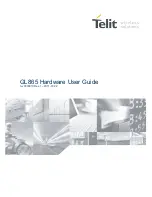
Brick Motion Controller Hardware Reference Manual
30
System Wiring
I7m04: PFM Pulse Width Control
The pulse width is specified in PFM clock cycles and has a range of 1 to 255 cycles. The default value is
15. Since the default value of PFM clock is actually set to 9.8304 MHz, the default output pulse width
will be 15/9,830400 = 1.5258
µ
S. Note that when the PFM clock values are changed, the PFM pulse
width values must be evaluated for proper stepper drive operation.
The user of a typical stepper drive should not need to modify these control variables. However, PFM
pulse width should be increased if the stepper drive’s input cannot handle the speed of the pulse output.
This often occurs with slow opto-couplers used on stepper drive inputs.
Single-Channel I-Variables
Each Servo IC has four channels n, numbered 1 to 4. For the first (standard) Servo IC on the Brick Motion
Controller, the channel numbers 1 – 4 on the Servo IC are the same as the channel numbers 1 – 4 on the
board. For the second (optional) Servo IC on the Brick Motion Controller, the channel numbers 1 – 4 on
the Servo IC correspond to board channel numbers 5 – 8. The most important variables are:
I7mn0: Servo IC m Channel n Encoder Decode Control
Typically, I7mn0 is set to 3 or 7 for x4 quadrature decode, depending on which way is up. If the channel
is used for open-loop stepper drive, I7mn0 is set to 8 to accept internal pulse-and-direction.
Caution:
If I7mn0 and I7mn8 are not matched properly, motor runaway will occur.
I7mn6: Servo IC m Channel n Output Mode Select
I7mn6 determines whether the A and B outputs are DAC or PWM, and whether the C output is PFM
(pulse-and-direction) or PWM. Typically, it is set to 0, either for 3-phase PWM, or to 3 for DACs and
PFM.
Set the output mode for the Brick Motion Controller for Pulse Frequency Modulation output (PFM),
I7mn6 equal to
2
.
I7mn8: Servo IC m Channel n PFM Direction Signal Invert Control
The polarity of the direction output is controlled by this I-variable. This output establishes an active low
or high output.
This I-variable works in conjunction with I7mn0. To operate correctly with the Brick Motion Controller,
if I7mn0 is set to 0, then I7mn8 is set to 0. If I7mn0 is set to 4, then I7mn8 is set to 1.
Caution:
If I7mn0 and I7mn8 are not matched properly, motor runaway will occur.
The Brick Motion Controller applies its gain formulas the same way it does for a classic servo system.
The basic difference with a stepper system is that most of the times, the typical encoder feedback
interface is handled using electronic circuitry rather than a physical encoder.
When the stepper output interface is selected, it allows the use of an electronic encoder feedback or a
physical encoder feedback. When used with an actual physical encoder, the axis should be tuned as if it
were a typical servomotor.
The process of tuning the simulated feedback loop is identical to tuning a servomotor with the exception
that some of the parameters become more predictable.
Содержание 5XX-603869-XUXX
Страница 4: ......
Страница 5: ...REVISION HISTORY REV DESCRIPTION DATE CHG APPVD 1 MANUAL CREATION 05 02 07 CP S MILICI ...
Страница 6: ......
Страница 14: ...Brick Motion Controller Hardware Reference Manual 6 Specifications ...
Страница 24: ...Brick Motion Controller Hardware Reference Manual 16 System Wiring Amplifier Fault Amplifier Enable diagrams ...
Страница 50: ...Brick Motion Controller Hardware Reference Manual 42 Appendix C Dimensional Layout and Connector location ...













































